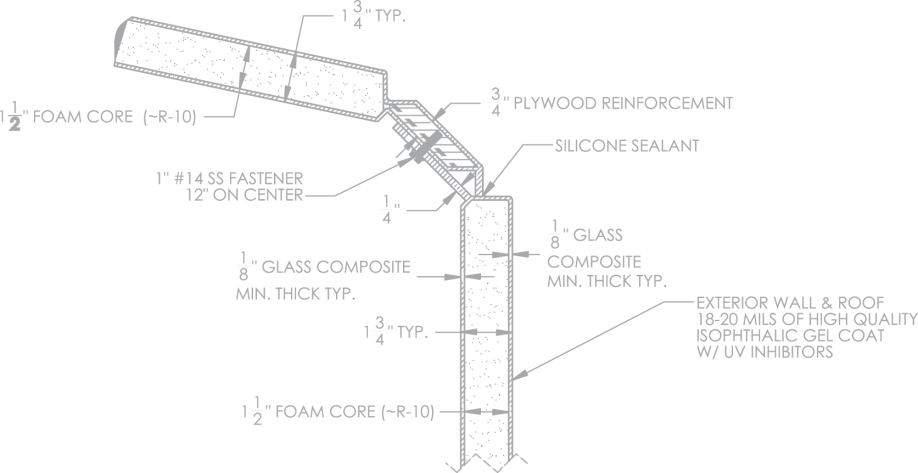Composites: The Future of Sustainable Building And Construction Products
Unlocking the Environmental Benefits of Recycled Compounds in Building and Design
In the world of building and construction and design, the use of recycled compounds holds substantial assurance for improving sustainability practices and reducing environmental effect (composites). By including these cutting-edge materials, there is a potential to attend to important concerns such as waste reduction, energy preservation, and a decline in carbon footprint. The change towards an extra lasting future in these markets depends upon unlocking the full capacity of recycled composites. This conversation will certainly explore the multifaceted benefits and difficulties connected with incorporating recycled compounds right into construction and layout, providing a glimpse into the transformative possibilities that exist in advance.

Environmental Effect Decrease
The decrease of ecological impact via the use of recycled composites in building and style plays a crucial role in lasting techniques. By incorporating recycled composites into building products, the building industry can substantially reduce its carbon footprint and add to an extra environment-friendly future. These sustainable products, made from repurposed plastics, wood fibers, or various other recycled components, provide a feasible option to standard building materials without compromising on high quality or sturdiness.
Recycled composites assist divert waste from garbage dumps and lower the requirement for extracting resources, hence preserving all-natural resources. Additionally, the manufacturing procedure of these composites commonly consumes much less energy and produces fewer greenhouse gases contrasted to producing virgin materials (composites). This shift in the direction of using recycled composites not just decreases ecological injury but likewise promotes a round economy by urging the reuse of materials that would certainly or else be discarded
Waste Minimization
With a concentrate on reducing waste in building and construction and layout, the assimilation of recycled compounds offers a lasting option to lower environmental influence. Waste reduction is a vital element of lasting methods, and making use of recycled compounds presents an opportunity to achieve this goal successfully. By utilizing materials that have currently offered their preliminary purpose, such as recycled plastics or recovered timber fibers, the building and construction and design sectors can considerably decrease the amount of waste generated and sent to garbage dumps.
Recycled composites have the possible to draw away considerable amounts of waste from conventional disposal methods, adding to a more round economy where sources are made use of effectively. In addition, the production process of recycled compounds frequently consumes less power and produces less discharges contrasted to virgin products, additionally reducing the ecological footprint of building and construction and layout tasks.
Carrying out waste reduction techniques with the unification of recycled composites not just helps in conserving natural deposits but additionally advertises a more lasting method to structure and creating for a greener future.
Energy Preservation
Integrating recycled composites not only minimizes waste in construction and style however additionally plays a vital duty in boosting power conservation techniques within the market. The use of recycled composites in building and construction can dramatically contribute to energy preservation with various methods. To start with, the production of virgin materials generally needs considerable power inputs, whereas making use of recycled composites consumes much less power, therefore reducing overall power usage. Additionally, click site including recycled composites can add to much better insulation homes in buildings, decreasing the demand for excessive home heating or cooling, and consequently reducing power usage for climate control. The light-weight nature of several recycled compounds can lead to lighter structures, needing much less energy for transportation and installment. By promoting using recycled compounds in building and construction and design, the market can make significant strides towards accomplishing energy effectiveness and decreasing its carbon impact, inevitably adding to a more lasting constructed atmosphere.
Carbon Footprint Decrease
Enhancing sustainability practices with the application of recycled composites in building and construction and design considerably decreases the carbon impact of the market. By incorporating recycled products into the manufacturing of composites, the requirement for virgin sources lowers, resulting in reduced power intake and greenhouse gas exhausts linked with conventional production procedures. This decrease in carbon footprint is crucial in combating environment change and promoting a much more eco-friendly approach to building and construction and style.
The carbon footprint reduction achieved via the fostering of recycled compounds aligns with the international push towards lasting techniques and the reduction of industrial discharges. Ultimately, by prioritizing the combination of recycled composites, the market can make significant strides in lowering its carbon check this impact and adding to a much more lasting future.
Lasting Future
The combination of recycled composites in building and design not only addresses immediate environmental concerns yet likewise lays a solid structure for a sustainable future in the industry. By incorporating recycled composites into building products and items, the building and style markets can considerably decrease their reliance on virgin sources, causing a more circular economy. This change in the direction of sustainability is essential for alleviating the ecological impact of standard construction methods, which often cause high degrees of waste generation and source exhaustion.

Verdict
To conclude, recycled composites supply substantial environmental benefits in construction and design by decreasing environmental effect, decreasing waste, conserving power, decreasing carbon impact, and promoting a lasting future. Accepting making use of recycled composites can add to a more environmentally-friendly strategy to building and layout, inevitably resulting in a more lasting and greener future for all.
The decrease of ecological influence via the usage of recycled composites in construction and design plays an important duty in lasting methods.With an emphasis on lessening waste in building and design, the combination of recycled composites provides a lasting service to minimize environmental effect. By advertising the usage of recycled composites in construction and style, the sector can make considerable strides towards accomplishing power effectiveness and minimizing its carbon footprint, eventually contributing to a more lasting constructed atmosphere.
